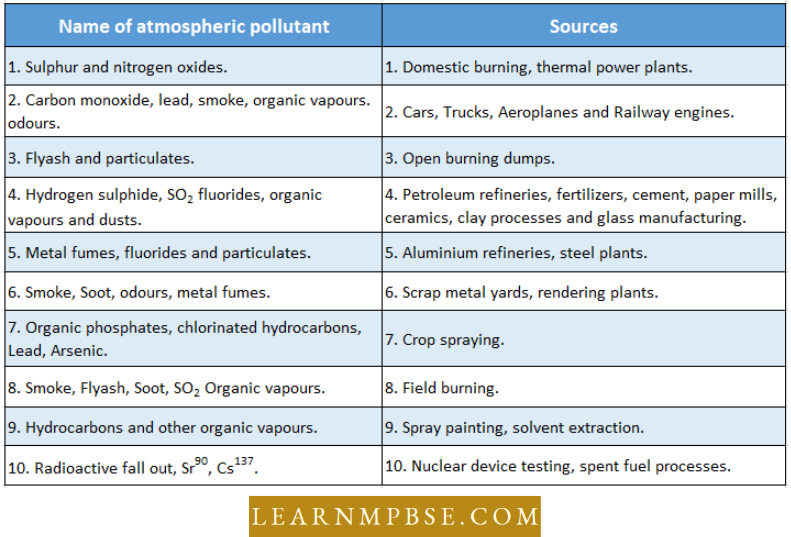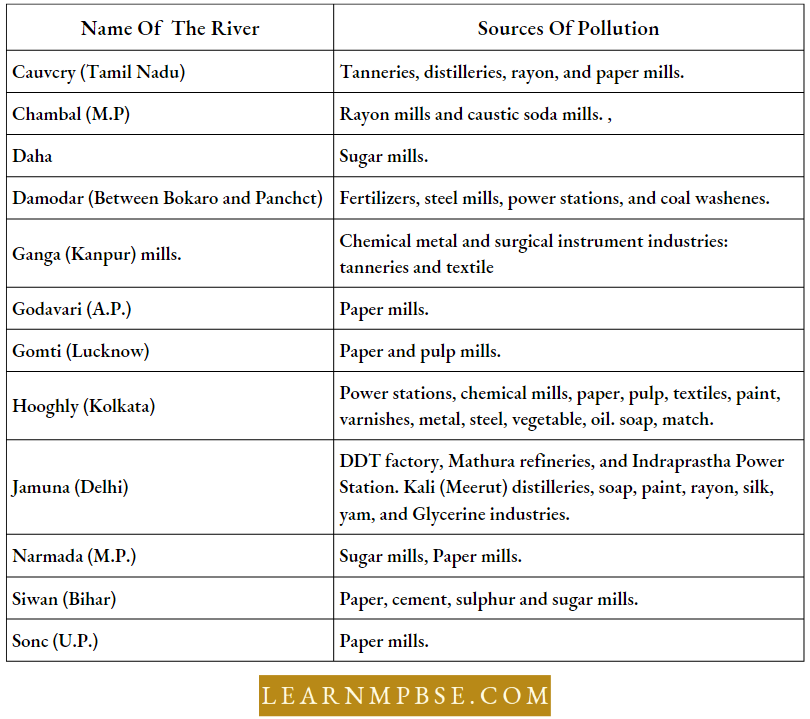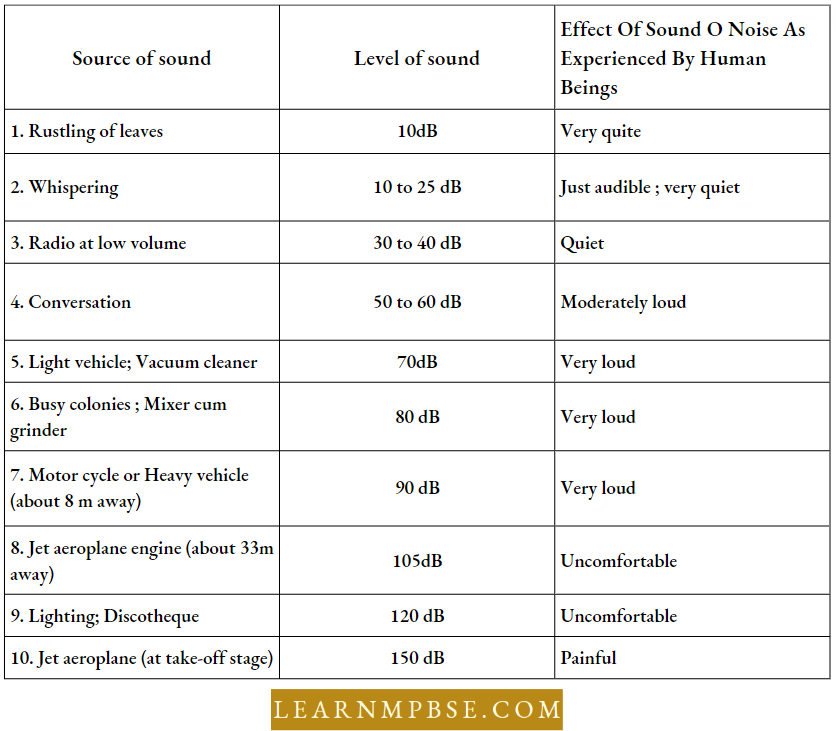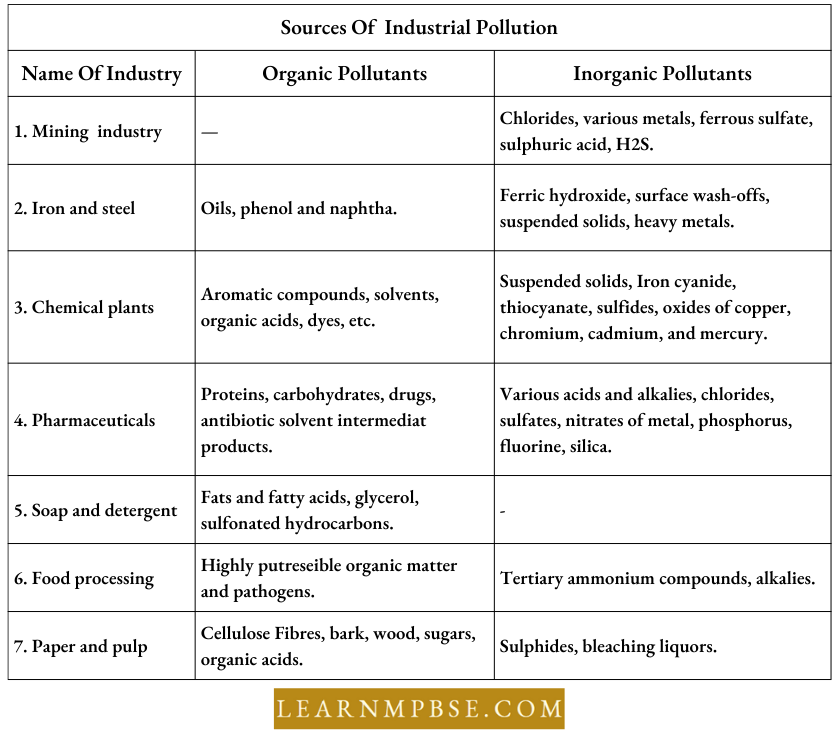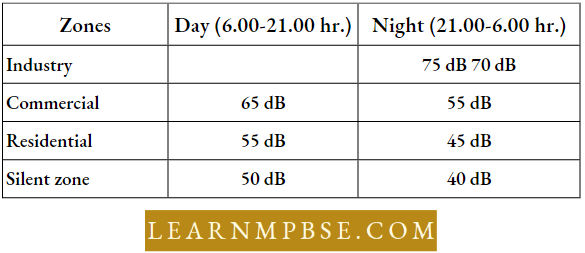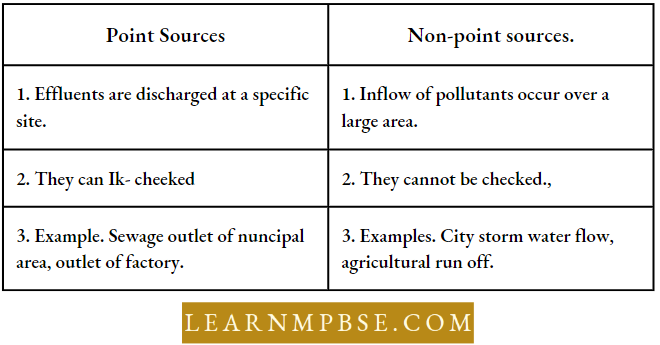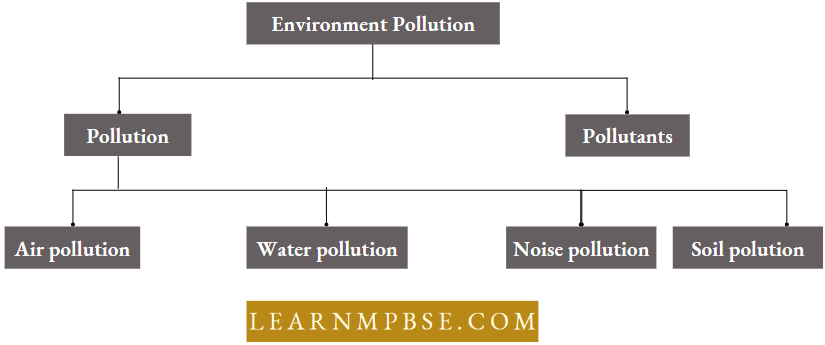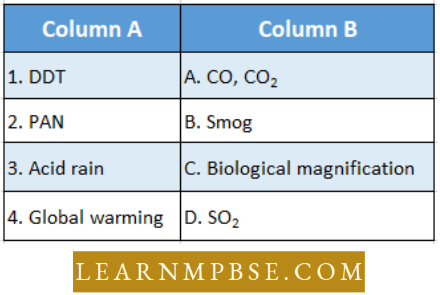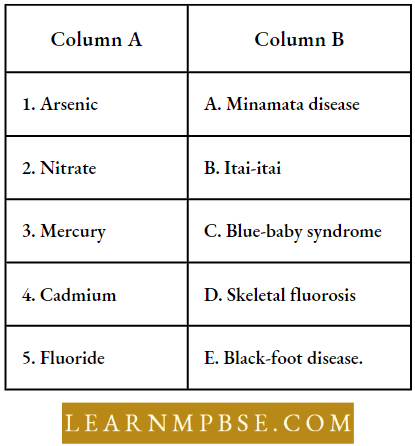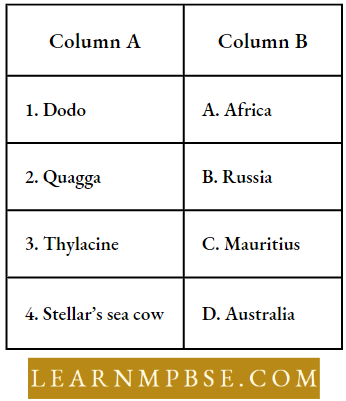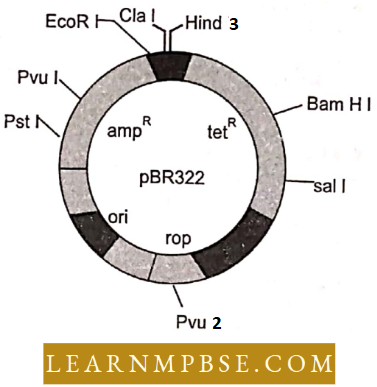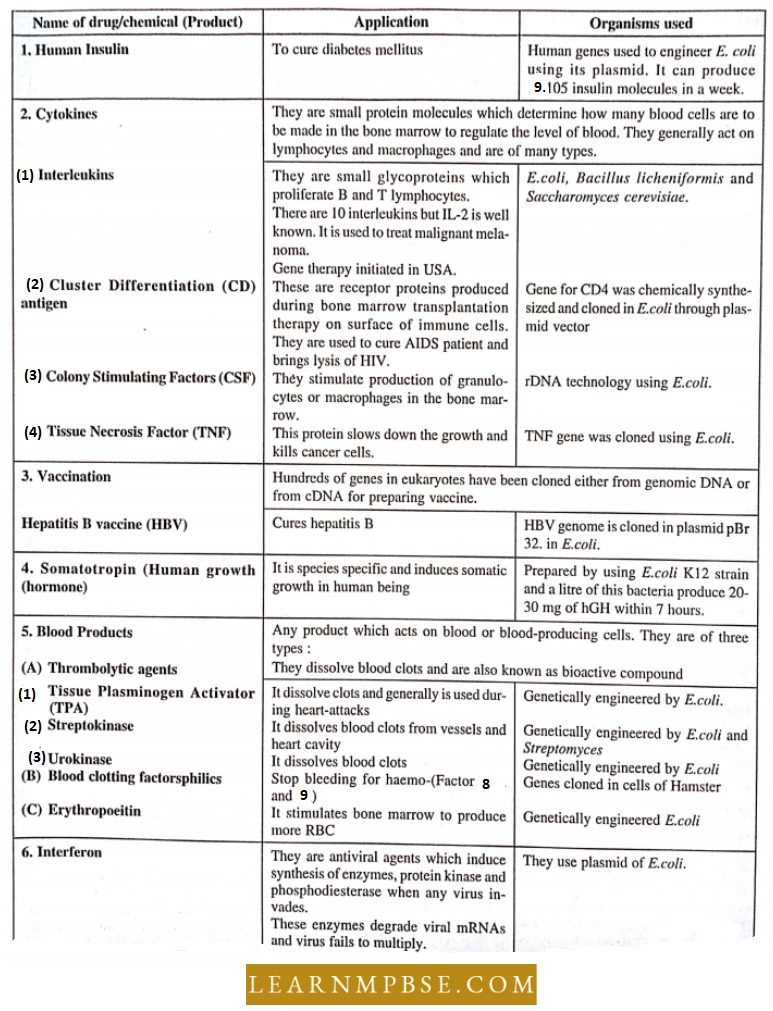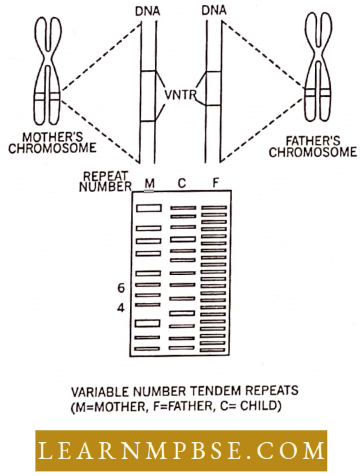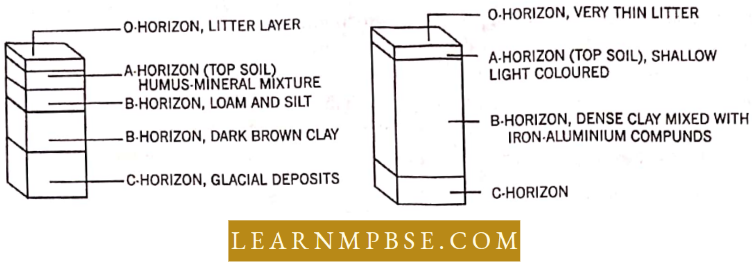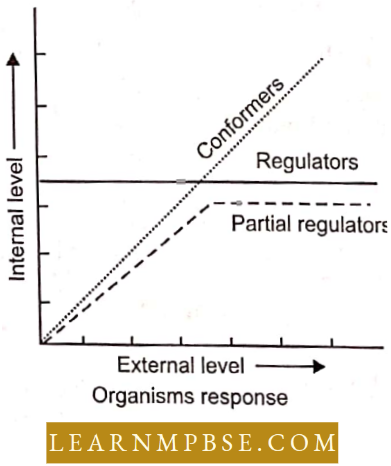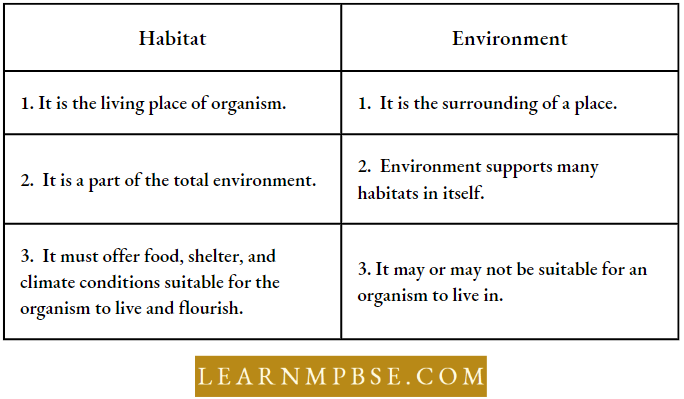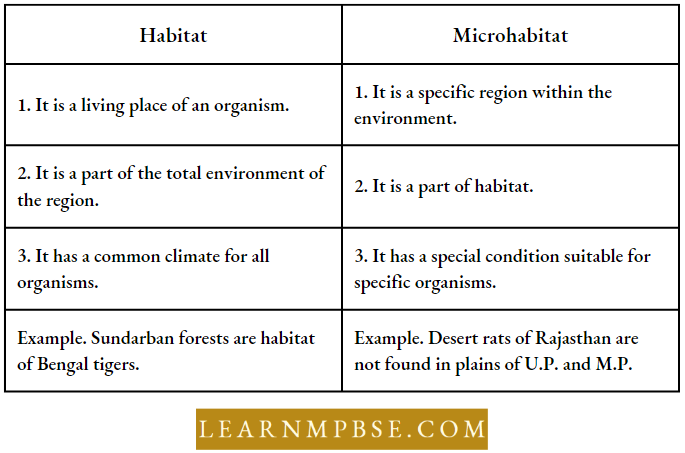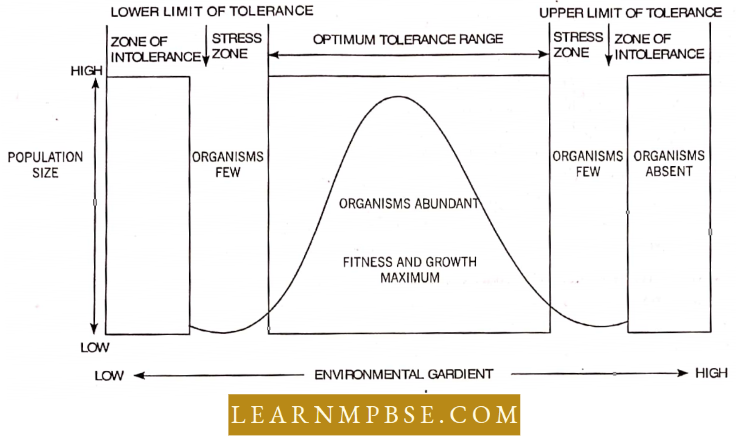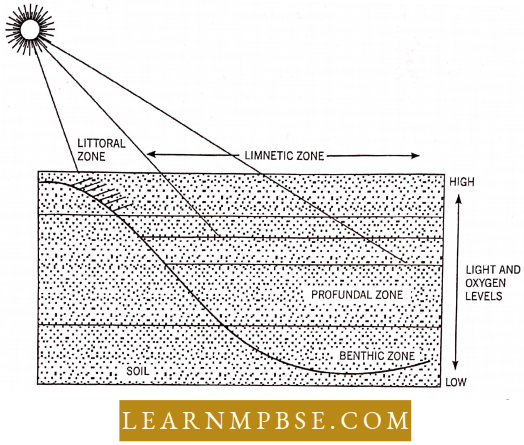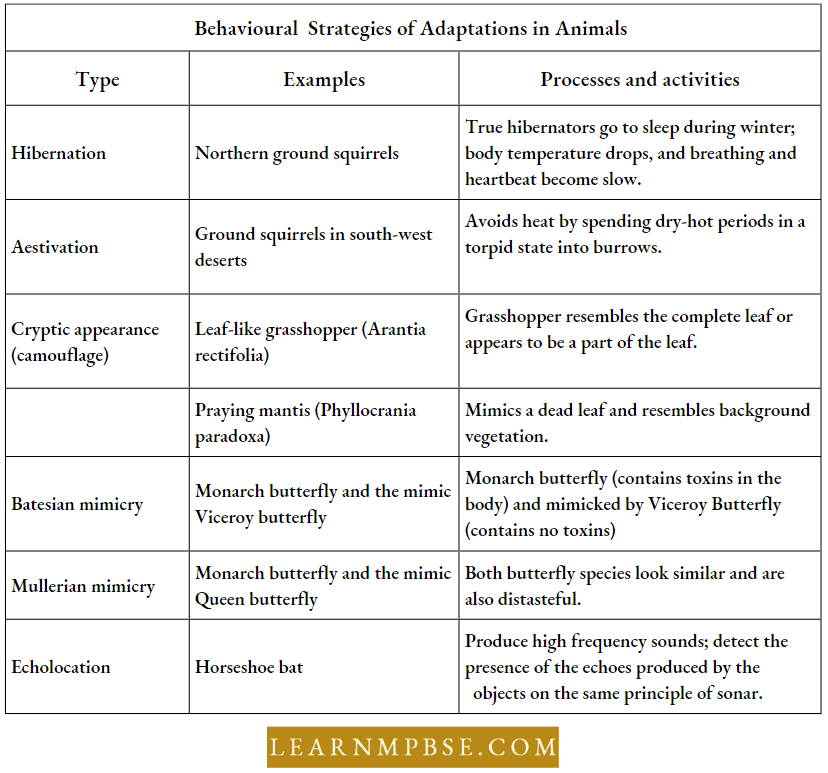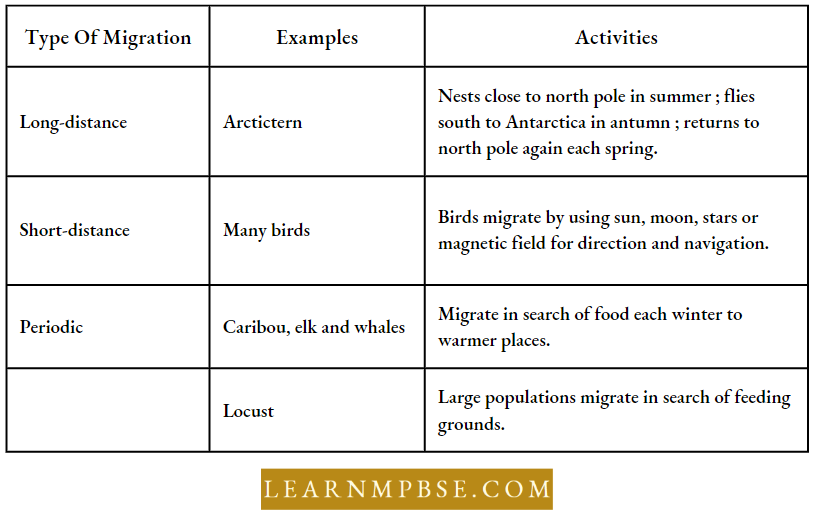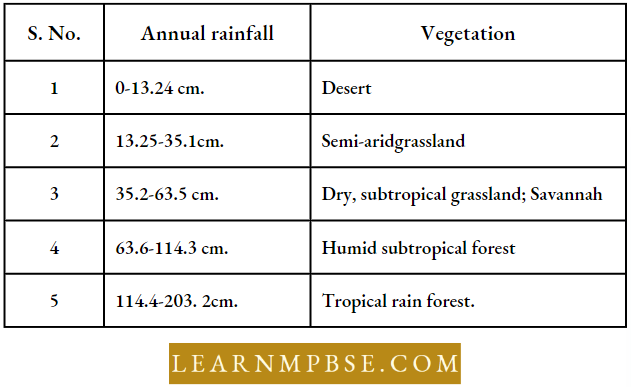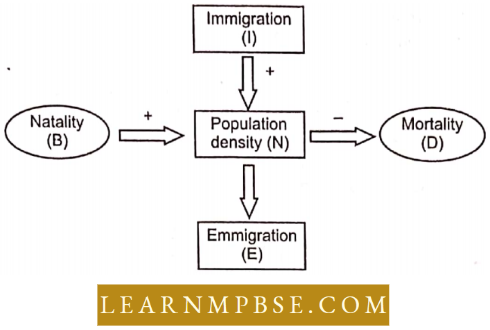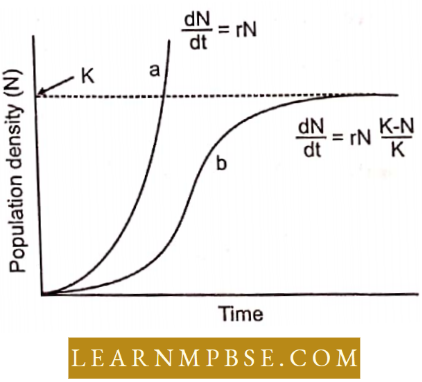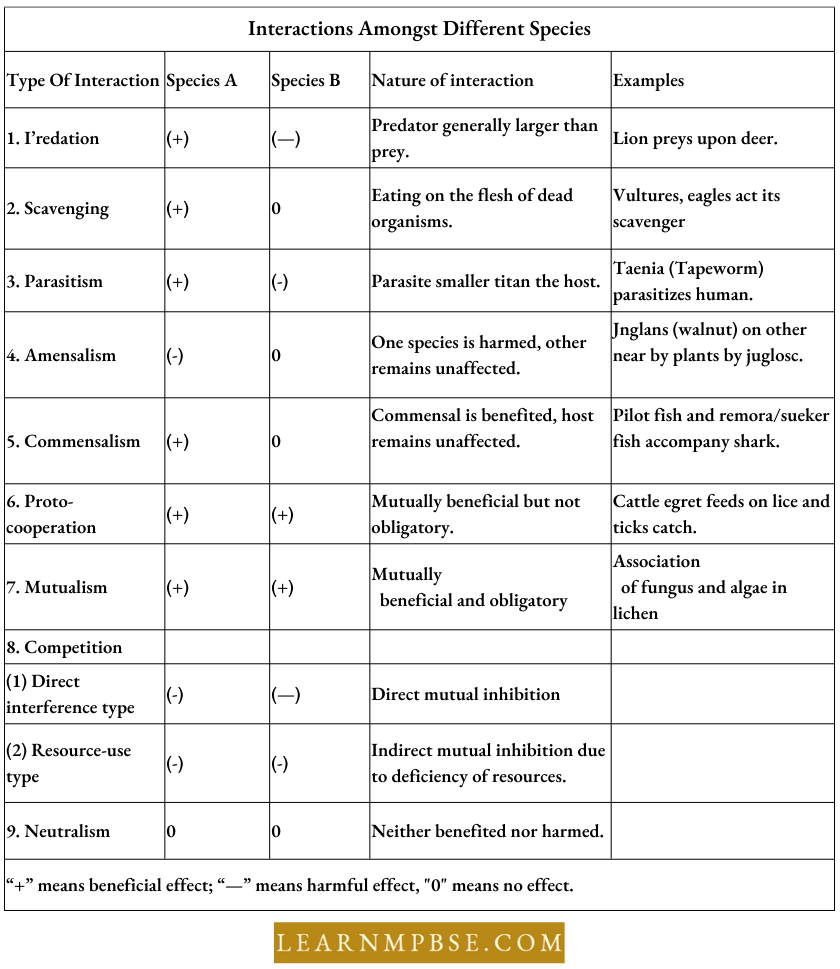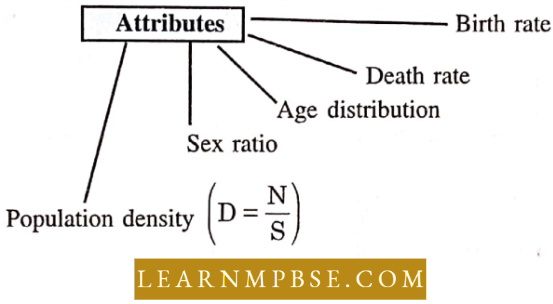NEET Biology Biodiversity and Wildlife Conservation Biodiversity. (Gk-Bios = Life; Diversity = Form)
It is the occurrence of different kinds of organisms and the complete range of varieties adapted to different climates, environments and areas being constituents of food chains and food webs of biotic interrelationship. Biodiversity refers to the totality of genes, species and ecosystems of a regi4n.
Biodiversity differs from place to place. As there is a continuous loss of biodiversity due to increasing population, resource consumption, urbanization and pollution, it is important to conserve it.
The basic reason for concern is that biodiversity is being lost even before it attains its size. Loss of biodiversity would check the evolutionary capability of biota to cope with an environmental loss.
Genetic Diversity. All living organisms store genetic information and functions according to the information coded in genes.
- Genetic diversity refers to the variation of genes within species. The differences could be in alleles (different variants of the same genes), in entire genes (the traits determining particular characteristics) or in chromosomal structures.
- Genetic diversity enables a population to adapt to its environment and to respond to natural selection. If a species has more genetic diversity, it can adapt better to the changed environmental conditions. Lower diversity in a species leads to uniformity, as is the case with large monocultures of genetically similar crop plants.
- This has an advantage when increased crop production is a consideration, but can be a problem when an insect or a fungal disease attacks the field and poses a threat to the whole crop.
NEET Biology Biodiversity And Wildlife Conservation Notes
Read and Learn More NEET Biology Notes
Species Diversity. The diversity includes the whole range of organisms found on earth. The number of identified species worldwide is between 1-7 and 1-8 million. However, the estimates of the total known species maybe 50 million. A large number of plant and animal species are yet to be identified. There are many more species to be present in the tropics.
Importance Of Species Diversity To Ecosystem:
Ecologists believe that communities with more species tend to be more stable than those with fewer species.
A stable community has the following attributes.
- It shall not show too much of variations in the year-to-year productivity.
- It must be either resistant or resilient to seasonal disturbances.
- It must be resistant also to invasion by alien species.
David Tilman had shown through his ecology experiments using outdoor plots, the following features.
- The plots with more species showed less year-to-year variation in the total biomass.
- Plots with increased diversity showed higher productivity.
- According to IUCN (2004), the total number of plant and animal species described is about 1.5 million.
- The species inventories for taxonomic groups in temperate countries/regions is more complete than those in tropical countries/regions.
- A more conservative and scientifically sound estimate has been made by Robert May; it puts the global species diversity at about seven million.
- More than 70% of all the species recorded are animals and plants account for about 22%; 70% of the animals are insects.
NEET Biology Biodiversity And Wildlife Conservation Notes
Biodiversity And Wildlife Conservation NEET Notes
These Estimates Do Not Give Any Figure For Prokaryotes For The Following Reactions:
- The conventional taxonomic methods are not suitable/sufficient for identifying these microbial species.
- Many of these species cannot be cultured under laboratory conditions.
- Biochemical and molecular biology techniques would put their diversity into millions.
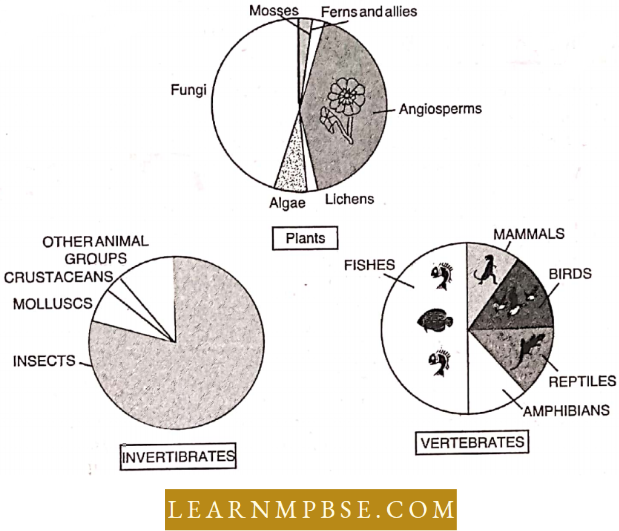
Ecosystem Diversity: Species are distinct units of diversity, each playing a specific role in the ecosystem.
- Diversity at the level of community and ecosystem has three perspectives i.e. Alpha, Beta and Gamma diversity.
- Ecosystem diversity describes the number of niches, trophic levels and other ecological processes that maintain energy flow, food webs and recycling of nutrients.
The Three Perspectives Of Diversity At the Level Of Community And Ecosystem Are:
- Alpha diversity
- Beta diversity and
- Gamma diversity.
- Alpha Diversity. It refers to the diversity of organisms sharing the same community. It has been found that there is an increase in diversity with a decrease in latitude.
- Beta Diversity. The rate of replacement of species along a gradient of habitat or communities is called beta diversity.
- Gamma Diversity. It is the rate at which additional species are found as replacements in different localities of the same habitat.
Gradients Of Biodiversity: Biodiversity varies with changes in latitude or altitude. As we move from high to low latitudes (i.e., from the poles to the equator), broadly speaking, the biological diversity increases.
- In the temperate region, the climate is severe with short growing periods for plants. In tropical rainforests, the conditions are favourable for growth throughout the year.
- Favourable environmental conditions favour speciation and make it possible for a larger number of species to occur and grow.
- For example, the mean number of vascular species per 0-1 ha sample area in tropical rain forests varies from 118-236, whereas it is only in the range of 21-48 species in the temperate zones.
- Latitudinal and altitudinal gradients of species diversity are two master gradients of biodivorsity.
NEET Biodiversity And Wildlife Conservation Chapter Notes
Patterns Of Biodiversity
- Biodiversity is not uniform throughout the world but varies with changes in latitude and attitude.
- Favourable environmental conditions favour speciation and make it possible for a large number of species to exist there; i.e. biodiversity is more in such areas than in others.
- Latitudinal Gradients
- Species diversity decreases from the equator towards the poles.
- The tropics (between 23.5° N to 23.5°S) harbour more species than temperate and polar regions.
- For example. Columbia situated near the equator, has about 1400 species of birds, while New York (41°N) has 105 species. Greenland (71°N) has about 56 species and India (in the equator region’) has 1200 species.
- The number of species of vascular plants in the tropics is about ten times more than that of temperate forests.
- The Amazonian rain forest in South America has the greatest biodiversity on earth; it harbours about 40000 species of plants. 1.25.000 species of insects. 3000 of fishes, 427 of amphibians, 3.78 of reptiles. 1300 of birds and 427 of mammals.
- Species-Area relationship
- Alexander Von Humboldt has observed that within a region, species richness increased with increased explored area, but only up to a limit.
- The relationship between species richness and area for a number of taxa like angiospermic plants, freshwater fishes and birds is found to be a rectangular hyperbola.
- On a log scale, the relationship becomes linear (straight line) and is described by the equation.
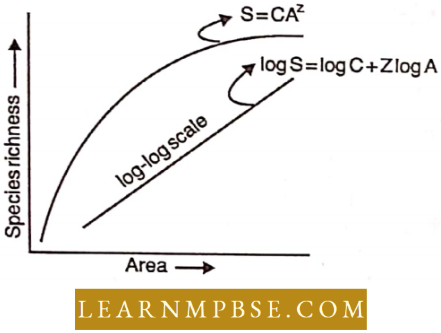
log S = log C + Z log A.
where, S = Species Richness Z = slope of a line (regression coefficient)
A = area and C = y-intercept
Ecologists have found that the value of the Z-line ranges between 0.1 and 0. irrespective of the taxonomic group or the region.
But in this analysis in very large areas like a continent, the Z-value ranges between 0.6 and 1.2.
The Z value for frugivorous birds and mammals in tropical forests is found to be 1.15.
Biodiversity And Wildlife Conservation NEET Notes
Use Of Biodiversity In Agriculture
- As a source of new crops.
- As a source material for breeding varieties.
- As a source of new biodegradable pesticides.
Only 20% of total plant species are cultivated to produce 85% of the world’s food.
Wheat, com and rice, the three major carbohydrate crops, yield nearly two-thirds of the food sustaining the human population. Fats, oils, fibres, etc. are other uses for which more and more new species need to be investigated.
Drugs And Medicines From Biodiversity:
Numerous significant medications have derived from botanical sources.
- Examples of plant-derived compounds transformed into important pharmaceuticals include
- Morphine (Papaver somniferum), utilized as an analgesic; Quinine (Chinchona ledgeriana), employed in malaria treatment; and Taxol, an anticancer agent synthesized from the bark of the yew tree (Taxus brevifolia, T. baccata).
- Presently, 25% of the pharmaceuticals in the pharmacy originate from only 120 plant species.
- However, globally, traditional medicines utilize thousands of plant species.
- Plants can also be utilized in the production of countless synthetic goods known as botanochemicals.
Aesthetic And Cultural Benefits From Biodiversity:
Examples of aesthetic rewards include ecotourism, bird watching, wildlife, pet-keeping, gardening etc. Throughout human history, people have related biodiversity to the very existence of the human race through cultural and religious beliefs.
Biodiversity Is Essential For The Maintenance And Sustainable Utilization of goods and services from ecological systems as well as from individual species.
NEET Biodiversity And Wildlife Conservation Chapter Notes
Causes Of Loss Of Biodiversity: Biological diversity is lost before its size is known.
- Increased human population.
- Consumption of resources.
- Pollution due to human activities.
Consequences Of Loss Of Biodiversity
- It would check the evolutionary capability of biota to cope with environmental changes.
- It would result in the extinction of species.
- As man is dependent on food and other necessities, its loss will be hard-pressed for mankind.
Threats To Biodiversity: Important factors leading to extinction of species and consequent loss of biodiversity are
- Habitat Loss And Fragmentation
- It is the most important or primary cause of extinction.
- The tropical rain forests initially covered 14% of the land surface of the earth, but now they cover only 6% of the land area.
- The Amazonian forests, called the ‘Lungs of the planet’, are cleared for cultivation of soyabean or conversion into grasslands for raising beef cattle.
- Total loss of a habitat deprives many animals and plants of their homes and they face extinction
- Degradation of habitats by pollution threatens the survival of many species.
- When a large habitat becomes fragmented, animals requiring large territories and those with certain migratory habits are adversely affected and their populations start decreasing.
- Introduction Of Exotic Species Leading To Endangering The Species: Exotic species are having a large impact, especially in island ecosystems, which harbour much of the world’s threatened biodiversity. A few examples are
- Nile perch, an exotic predatory fish introduced into Lake Victoria (South Africa) threatens the entire ecosystem of the lake by eliminating several native species of the small Cichlid fish species that were endemic to this freshwater aquatic system.
- Water hyacinth clogs rivers and lakes and threatens the survival of many aquatic species in lakes and river flood plains in several tropical countries including India.
- Lantana camara has invaded many forest lands in different parts of India and strongly competes with the native species.
- Over-exploitation of soil, water,
- Atmospheric pollution and
- Intensive agriculture and forestry.
Biodiversity And Wildlife Conservation Class 12 Notes For NEET
Protected Areas: These areas are land or sea dedicated to the protection and maintenance of biological diversity. They include National parks. Sanctuaries and Biosphere Reserve. As of Sept. 2002. India has 581 protected areas.
- National Parks. A national park is an area which is strictly reserved for the betterment of wildlife and where activities like forestry, grazing or cultivation are not permitted. In these parks, even private ownership rights are not allowed.
- Sanctuaries. A sanctuary is a protected area which is reserved for the conservation of only animals and human activities like harvesting of timber, and collection of minor forest products and private ownership is allowed so long as they do not interfere with well well-being of animals.
- A biosphere reserve is a specified area in which multiple use of the land is permitted by dividing it into certain zones, each zone being specified for a particular activity.
Biosphere Reserve: A biosphere reserve is a specified protected area of land and/or coastal environment in which multiple use of the land is permitted by dividing it into zones, each for a particular activity.
Types Of Biodiversity NEET Biology
Recently, the concept of Biosphere Reserve has been evolved by UNESCO’s Man and Biosphere Programme (MABP). Till May 2002, there are 408 biosphere reserves located in 94 countries out of which 13 are in India. Of these, the Nilgiri Biosphere Reserve was declared in 1986.
Zones of Biosphere Reserve. A biosphere reserve is divided into three zones: core, buffer and manipulation.
- Core Zone. No human activity is allowed in the core zone.
- Buffer Zone. Limited human activity is permitted in the buffer zone.
- Manipulation Zone. Several human activities can occur in the manipulation zone.
Types Of Biodiversity NEET Biology
Role of a Biosphere Reserve. A biosphere reserve preserves
- Conservation of wild populations,
- Development, and
- Genetic resources of domesticated plants and animals carrying out scientific research monitoring and education.
Benefits Of Protected Areas
- Maintaining viable populations of all native species and subspecies.
- Maintaining the number and distribution of communities and habitats, and conserving the genetic diversity of all the present species.
- Preventing human-caused introduction of alien species.
- Making it possible for species/habitats to shift in response to changes in the environment.
Ex-situ Conservationhttps://learnmpbse.com/neet-biology-organisms-and-population-ageing-and-death-notes/. It means maintenance of offsite collections either in gardens by farmers, and botanical gardens or storing seeds, genes, pollen, tissue culture etc.
- The rare plants have been found to flourish in large numbers under the care and protection of gardeners and nature lovers.
- Farmers have been maintaining genetic diversity (enormous varieties) of crop plants since ancient times by saving seeds or other components for the next plantings.
- Collection of samples of cultivated and wild varieties of plants and storing them in botanical gardens is another method of conservation of germplasm.
- In seeds, the living material remains in a metabolically suspended state. When the seeds are to be stored for longer periods, it is necessary to avoid conditions which favour respiration and enzymatic action.
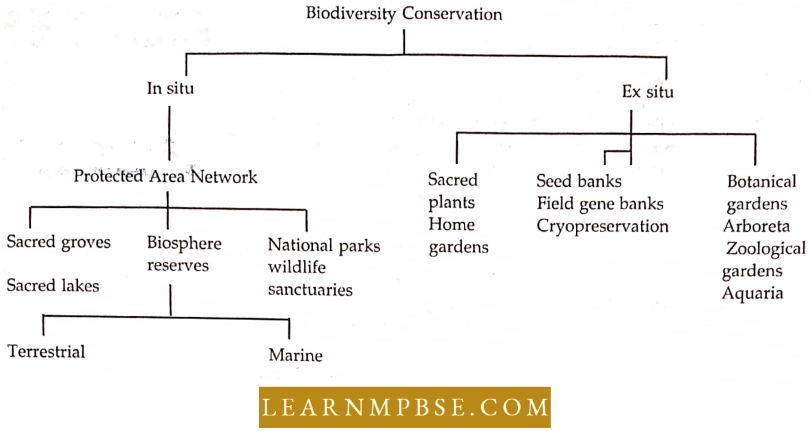
Hot Spots Of Biodiversity: The concept of ‘Hot-spots’ was developed by Norman Myers (1988) to designate specific areas for in-situ conservation. The hot spots are the richest and most threatened reservoirs of plant and animal life on earth.
NEET Biology Biodiversity And Wildlife Conservation Important Points
The Criteria For Determining Hot Spots Are:
- Number of endemic species.
- Degree of threat which is measured in terms of habitat loss.
There are 25 hot spots in the world out of which two are in India. They are the Western Ghats and Eastern Himalayas.
Hot spots of the Eastern Himalayas are active centres of evolution and rich in diversity of flowering angiosperms. Western Ghats have semi-evergreen forests. The Western Ghats include two main centres of biodiversity i.e., Aqastyamalai Hills and Silent Valley.
IUCN Red List. It is a catalogue of taxa that are facing the risk of extinction. The uses of the red list are
- Developing awareness, about the threat of loss of biodiversity
- Identification and documentation of endangered species.
- Providing a global index of the decline of biodiversity.
- Defining conservation.
IUCN Red List Categories
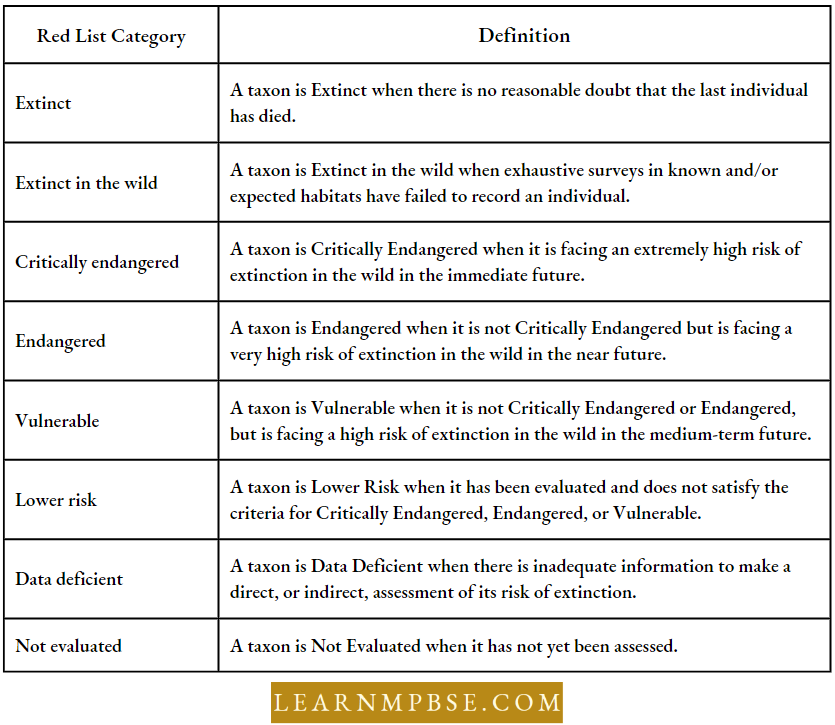
NEET Biology Biodiversity and Wildlife Conservation Natural Resources
Natural Resources are components of the biosphere and include energy, air, land, water, minerals, plants, animals and microorganisms.
As a result of manipulation by man, the biosphere has become transformed into a human-dominated environment called Noosphere (noo = mind, sphere = domain).
Natural Resources Are Categorised As Follows:
Depending on the availability and abundance the natural resources are classified into the following kinds
- Inexhaustible Resources. These resources are not likely to be exhausted by man’s consumption and other uses. They are, for example, wind, tidal energy and precipitation.
- Exhaustible Resources. These are the resources which are likely to be exhausted by man’s consumption.
Kinds of natural resources based on renewability
- Renewable Resources. These resources are naturally replenished after man’s consumption. They have the inherent capacity to reappear by quick recycling. They are water, wood, soil, natural pastures living organisms etc.
- Non-Renewable Resources. The resources that cannot be replaced faster than they are used. They are fossil fuels and mineral ores.
Kinds Of Natural Resources Based On Composition

There Are Three Types On The Basis Of The Ownership.

- Other direct sources of energy are sunlight, hydroelectric and wind power, tidal energy, and nuclear and geothermal energy.
- Presently, the major energy sources arc fuel wood and fossil fuels (coal, petroleum and natural gas).
- Per capita energy consumption per day in the U.S.A. has reached 2,50,000 keal. It is as low as 10,000 kcal in developing countries.
- Thirty per cent of the world’s population, living in industrialized countries, consume about 80% of total global energy.
NEET Biology Biodiversity and Wildlife Conservation Type Of Soil Components And Vegetation
Soil. It is a weathered superficial layer of the earth’s crust which is capable of supporting life.
Soil As A Resource. Landforms about 1l/5th of the earth a major constituent of the lithosphere and are the source of many materials, which are used by man.
All the terrestrial plants obtain their water and mineral nutrients from the soil. The yield of all biotic products in terrestrial ecosystems depends upon soil. Numerous microbes (bacteria and fungi) and many animals which are involved in the decomposition process live in the soil. All of them form humus by accumulation of partially synthesised organic materials.
Importance Of Biodiversity Conservation NEET Study Material
Pedology. The branch of science which deals with the study of soil is called pedology.
Origin Of Soil. The processes of soil formation are generally divided into two stages:
- Weathering. The breakdown of bigger rocks into fine mineral particles is called weathering. It is mostly a physical or chemical process.
- Chemical Weathering. It is caused by oxidation, hydrolysis or carbonation.
- Mechanical Weathering. It is caused by living organisms, for example, lichens, grazing animals or earthworms.
- Pedogenesis Or Soil Development (Soil Maturation). It is a constructive biochemical process which converts the disintegrated mass of rock particles into mature soil. It consists of humification, eluviation and illuviation.
- Humification. The remains of plants and animals undergo decomposition to produce an amorphous colloidal complex called lumens. The process of formation of humus is known as humification.
- Eluviation And Illuviation. Washing down or leaching the contents of the upper layer of the soil is called eluviation and the decomposition of the contents of the upper layer in the deeper layer is called Illuviation. These two processes go on simultaneously.
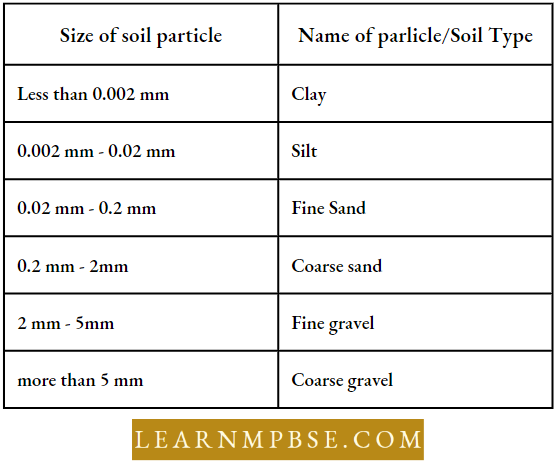
- Sandy Soils: Mainly sand.
- Clayey Soils: Mainly clay.
- Loamy Soils: Sand, silt and clay.
- Sandy Loam Soils: Sand particles are dominating
- Silt Loam Soils: Silt particles are dominating
- Clayey Loam Soils: Clay particles are dominating
Types Of Vegetation On The Basis Of Nature Of Soil
- Rock Soil: Lithophytes
- Sandy Soil: Psammophytes
- Humus Or Acidic Soil: Oxylophytes
- Cold Soil: Psychrophytes
- Crevices Of Rocks: Chasmophytes
- Deserts: Gemophytes
- Saline Or Alkaline: Halophytes
Types Of Soil On The Basis Of Origin
- Skeletal Or Immature Soil. Partly weathered parental rocks.
- Residual Soil (Sedentary Soil). Soil exists in the place of their origin.
- Transported Soil. Shifted to different places.
- Alluvial Soils. Transported by the water of rivers.
- Colluvial Soils. Shifted due to gravitational force.
- Aeolian Soil. Shifted by wind.
Leaching. It is an important factor which makes the soil poor in its resources. In this process, minerals and organic substances are removed from the top layer of soil by rainwater.
Importance Of Biodiversity Conservation NEET Study Material
Biological Agencies. They are also active in causing loss of resources from the soil. Cultivation of soil year after year makes the soil less productive.
Mulching. Use of artificial protective covering having a mixture of wet straws, leaves etc.
- Man-land ratio in India is very low i.e. 0.48 hectare per capita of available land.
- Of the particulate constituents, clay and humus mainly are the determinants for the properties of soil.
- Sand and silt consist largely of quartz (SiO2), and are chemically inert.
Clay is chemically more active and possesses a high capacity to hold water and ions. Pure clay is not a suitable medium for plant growth, because it forms a solid impenetrable mass. However, if mixed with other constituents of the soil, the charges on the ions link the particles together to form aggregates (or crumbs) to produce granular soil.
Soils without clay particles are structureless, and powdery and are not capable of holding water and nutrients.
Soil Organisms. A large number of organisms occurring in the soil like bacteria, fungi, algae, protozoans, nematodes, insects, earthworms etc. are called soil organisms. The number of earthworms may be as high as 6,00,000 – 79,11,000 per hectare in Indian grassland.
(Dash 1978) Bacteria are the most abundant of all soil organisms (14 million to 58 million/gm.) followed by protozoans (10,000 – 2 million/gm).
These Organisms Play Following Important Roles In The Soil:
- Nitrogen fixation
- Mycorrhizal association
- Soil-borne diseases
- Decomposition of organic matter.
Humus is formed by the accumulation of partially decayed and partially synthesised organic materials such as cellulose, hemicellulose, lignin, sugar, lipids and proteins. It helps in making the soil granular.
- It causes air spaces to be formed in the clay soil and increases the water-holding capacity of sandy soils. Humus is rich in nutrients and thus enhances plant growth. Being black, humus absorbs heat and warms up the soil.
- Plant debris falling on the ground which is undecomposed is called litter. Broken and partially decomposed organic matter is called duff or more. The organic matter in acidic conditions does not decompose rapidly due to inhibition of microbial activities, this partially decomposed organic matter is called peat or muck.
Importance Of Top Soil: Soil plays a multiple role in the life of organisms
- It provides water and mineral nutrients to the terrestrial plants.
- It is the medium in which plant and animal materials are decomposed. The inorganic components, namely CO2, and H2O, formed as the end products of decomposition are released into the environment for reuse by plants.
- It provides a habitat for microbes.
Soil Erosion. In this process, the fertile soil surfaces are detached and deposited at other places.
Agents Of Soil Erosion
- Water Erosion. This type of soil erosion is caused by water. The raindrops fall on the superficial layers and erosion takes place due to the flow of water.
- Sheet Erosion. Due to heavy rain, the top fertile soil is removed in the form of a thin sheet.
- Rill Erosion. Fast-running water cut stream or groove-like structures in soil.
- Gully Erosion. On steep slopes, fast-running water cuts the soil deep and forms channel-like structures called gullies.
- Ravine Erosion. During floods fast running water cut off the margins of the river. Due to heavy rains, the minerals are also lost from the topsoil and the soil becomes less fertile.
- Wind Erosion. In deserts, soil erosion takes place continuously due to wind and cyclones.
- Land Slides Or Slip Erosion. Due to heavy rains, the edges of hills are washed away and due to gravity, they fall.
- Stream Bank Erosion. Due to floods, the banks of rivers are eroded.
Principles Of Soil Erosion
- Normal Or Geological Erosion. This is a slow process. It is a common natural phenomenon. A balance is maintained between formation and erosion.
- Accelerated Soil Erosion. In this type of erosion, a balance is not maintained between erosion and formation. The speed of erosion is so fast due to man or any other reason that it is impossible to have a similar formation speed. Due to this type of soil erosion man has to face many problems.
Biological Methods Of Soil Conservation
- Contour agriculture
- Mulching
- Crop rotation
- Dry farming.
Importance Of Biodiversity Conservation NEET Study Material
Restoration Of Soil Fertility
- The application of biofertilizers is useful in enhancing soil fertility.
- Various organic farming measures, which provide increased input to soil have long-term beneficial effects on soil futility.
NEET Biology Biodiversity and Wildlife Conservation Sources Of Water
The sources of water on earth are oceans, rivers, lakes, soil moisture and groundwater.
Oceans contain 97% of 14 billion cubic kilometres (km³) of remaining water. Ice in the polar ice caps and permanent glaciers had about 3% of the remaining water. The rest of the water is in the form of water vapours, lakes, rivers and groundwater.
List Of Marine Resources
The global hydrological cycle enables oceans to provide a consistent supply of fresh water for human, animal, and plant utilization.
- The ocean serves as a repository for several compounds involved in biological cycles and various other items.
- Marine vegetation functions as a primary producer.
- Kelp and several marine organisms are utilized as sustenance.
- Iodine and industrial gums are derived from seaweeds.
- Agar is derived from the green algae Gracilaria and Gelidium.
- Algin is extracted from Sargassum and Turbinaria.
- Pearls derived from pearl oysters are utilized as precious adornments.
- Mollusc shells are utilized to produce quicklime.
- Sodium, chloride, magnesium, and bromide are derived from seawater.
- Petroleum and natural gas are extracted from continental shelves.
- The oceans provide as supplies of deuterium, uranium, gold, manganese, iron, lead, and sulfur.
Fresh Water:
Out of the 3%, 77.2% is stored in glaciers and icecaps and 224% is groundwater and soil moisture. The remaining 0.36% is present in lakes, rivers, streams, swamps etc. This fresh water is available for drinking and irrigation purposes. In the atmosphere, there is 0.00 J of water.
Ocean water is also very important for mankind. Man’s direct relation is more with fresh water. Rainfall is due to the evaporation of ocean water and as a result of this fresh water is available. 90% of the total evaporated oceanic water reaches back into the ocean.
Role Of Water In Supporting System:
Water plays a vital role in supporting the system as follows.
- It has an influence in regulating climate.
- The ocean acts as a heat bank for coastal regions releasing and absorbing heat.
- Waterfalls, tides and river currents are used to move machines and generate hydroelectric power.
- Water is essential for agriculture and industry.
- It provides a surface for navigation.
- Water provides the hydrogen required in living systems.
Conservation Of Water Resources:
For the conservation and management of freshwater following methods can be employed
- Reducing agricultural water wastage by increasing the efficiency of the irrigation system.
- Afforestation and protection of watersheds to improve economy.
- Formation of artificial clouds, so that a change can be brought into the atmosphere.
- Changes in the vegetation of a particular area, so that even in the dry season maximum amount of water can be stored. In addition to this dams should be constructed to stop the drainage of rainwater.
- Control the distribution of water by constructing big dams.
- Desalinization of seawater and saline groundwater.
- Proper utilization of underground water.
- Attempt to extract minerals from water.
- Melt the glaciers and snow for use as a freshwater resource.
- Regular dredging and desolation of water bodies.
Wetlands:
Wetlands are low-lying areas usually covered by shallow water and have characteristic soils and water-tolerant vegetation. Wetlands may be either freshwater or saltwater (coastal). Freshwater wetlands include marshes (where grass-like plants dominate), swamps (where trees or shrubs dominate), and periodically flooded riverine forests found in lowlands along streams.
Wetlands occupy almost 6% of the world’s land surface and provide crucial environmental services. Wetlands are often drained, dredged or filled up for housing and industrial purposes. They are increasingly threatened by agriculture, pollution and engineering constructions (such as dams).
Importance Of Wetlands
- They serve as groundwater recharge areas.
- To help clean and purify water runoff.
- They are highly productive areas.
- In saltwater wetlands, the mangroves hold sediment and accumulate soil along the shoreline.
- As mangroves expand into the ocean other plants colonize the soil left behind.
Measures For Salt Water Wetland Conservation: Coastal wetlands are called saltwater wetlands which include highly productive estuaries.
Threats To Biodiversity NEET Exam Preparation
Wetland Conservation:
Wetland conservation programmes are generally based on
- Preparation of wetland inventories.
- Identification of wetlands of critical importance for their protection.
- Checking waste disposal in wetlands.
- Reduction of excessive inflow of nutrients and silt into wetlands from surrounding uplands by keeping them under plant cover.
NEET Biology Biodiversity and Wildlife Conservation Grasslands
Grasslands, commonly referred to as rangeland, supply feed and shelter for domestic animals and wildlife. In rural regions, dried hay extracted from grasslands, especially from tall grasses, serves as fuel or thatching material.
Grass cover is exceptionally effective in binding soil particles through a densely branching fibrous root system, hence markedly diminishing soil erosion.
- In India, the extent of diverse grass cover, encompassing fallow and wastelands, is approximated to constitute around 18% of the total land area.
- Including the forested region, which constitutes approximately 19% of total land and predominantly facilitates grazing, roughly 37% of land is deemed available for grazing.
- India’s average annual yield of dry grass or hay is approximately 250 million tons.
Degradation of Grassland:
Degradation or destruction of grassland is mainly related to overpopulation. To enhance food production, grasslands possessing fertile soils are ploughed and converted to agricultural lands (for example North American prairies).
In developing countries, grassland areas are frequently overgrazed. For example, the number of animals grazing in the arid and semi-arid regions of India had been found to be 2-10 times greater than the capacity of the grassland to feed the animals.
Management Of Grasslands
- Protection from grazing
- Use of rotational grazing
- Removal of woody bushes or shrubs and weeds.
- Use of controlled burning to promote recycling of nutrients.
- Conservation of soil and water by reducing loss of soil and water.
NEET Biology Biodiversity and Wildlife Conservation Forests
A forest is a special biotic community of immense value to the environment and living beings.
- Forests provide a large number of products which are of great economic value such as timber, firewood, bamboo, cane, oils, resins and useful chemicals.
- In India, forests have been reported to cover 22.7% of land (74.8 million hectares).
- Remote sensing surveys have shown forest cover to be about 14%.
- Constitution of Indian forests
- Tropical dry deciduous forests (38.7%),
- Tropical moist deciduous forests (30.9%),
- Tropical thorn (6.9%),
- Plant sale and teak (13%).
- Forests check soil erosion, control air pollution and provide shelter to a large number of animals.
Conservation of forests involves the extraction of timber and wood on a sustainable basis, replantation of native species on a replaceable basis, and special afforestation programmes.
- The Union and State governments have launched several afforestation programmes.
- The Social Forestry Programme started in 1976, seeks the use of public and common land to produce firewood, fodder, and small timber for the use of the rural community to reduce pressure on existing forests needed for soil and water conservation.
Agroforestry programmes—aim at reviving ancient land use practices (same land used for farming, forestry and animal husbandry).
Urban forestry programme— consists of planting trees for aesthetic purposes in urban areas.
Forest Cover: In India, 74.8 million ha or 22.7% LAPD was under forest cover in 1980 (Central Forestry Commission). It has increased to 75.23 million hectares or 22.96% in 1993. Champion and Seth (1968) have recognised 16 forest types in India. 38.7% area is covered by tropical deciduous forests, 30.9% by tropical moist deciduous forests, 6.9% by tropical thorn, and 13% by Sal and Teak strands.
Threats To Biodiversity NEET Exam Preparation
Biological Methods Of Soil Conservation
- Contour agriculture
- Mulching
- Crop rotation
- Dry farming.
Restoration Of Soil Fertility
- The application of biofertilizers is useful in enhancing soil fertility.
- Various organic farming measures, which provide increased input to soil have long-term beneficial effects on soil fertility.
NEET Biology Biodiversity and Wildlife Conservation Importance Of Forest Resources
Productive Functions
- Forests Provide Wood. Indian forests yield valuable timber wood like teak, sal, deodar, shisha etc.
- Forests Provide Paper. The conifers and bamboo are used as raw materials to prepare paper.
- Medicinal Plants in forests provide medicine of great importance.
- Forests provide a number of products like resins, gums, rubber, food and insecticides.
- Forests provide shelter to a variety of animals.
- Forests also provide the cork for example oak (Quercus)
Protective Functions: Role of forests in the protection of lands. Forests play a vital role in the life and economy of all tribes living in the forests.
- Forests prevent the erosion of soil by wind and water.
- Large trees provide shade which prevents the soil from becoming dry and friable during the summer.
- They check the velocity of raindrops or wind striking the ground and reduce the dislodg¬ing of the soil particles.
- The root system of plants firmly binds the soil.
Role Of Forests In Retaining Sub-Soil Water: Forests improve the quality of soil by increasing its porosity. The forest soil absorbs water during rains like a giant sponge and does not allow it to evaporate or run off quickly.
It ensures a perennial supply of subsoil water in springs and wells. Thus the hill slopes with vast forest cover in the catchment areas conserve water and gradually release it into streams, rivers and subsoil springs.
Deforestation: According to an estimate; almost 40% of forests have been lost in the tropics and 1% of forests in the temperate region.
- In India, at the beginning of the twentieth century, forests covered about 30% of land whereas by the end of the century, it reduced to 19.4%.
- The National Forests policy (1988) has recommended 33% forest cover for plains and 67% for hills.
Causes For Deforestation.
- Forests are converted into agricultural lands to feed the growing human population.
- Forests are cleared for making homes and establishing industries.
- Trees are felled for timber, firewood, etc.
- Jhum cultivation in the north-eastern states has contributed to deforestation.
Consequences of Deforestation
- Carbon dioxide concentration in the atmosphere has increased.
- There is a loss of biodiversity due to habitat destruction.
- Deforestation disturbs the hydrological cycle.
- There is soil erosion and it may lead to desertification in extreme cases.
Forest Conservation: Before man’s evolution, 70% of the land was covered by forests, which is now only 16%. The forests were depleted due to river valley projects, commercial use, agriculture development etc. To stop the destruction of forests, forest management, social forestry and public efforts are also necessary.
Forest management should be such that along with the protection of forests, production should also increase.
Afforestation: Looking at the rapid destruction rate of forests, the National Agriculture Commission started a scheme in 1976 called social forestry. Under this scheme such trees were to be planted which give the fuel wood to the local people, fodder for their animals, tools for agriculture, some teak for making houses and minor forest produce etc.
Many afforestation programmes have been taken in hand by central and state governments.
- Social Forestry Programme (1976). It requires raising trees for fuel wood, fodder, agricultural implements and fruits on public and common lands for the benefit of rural communities. The programme is aimed at reducing the demand on existing forests needed for soil and water conservation.
- Agroforestry Programme. It is aimed at reviving the ancient practice of using the same land for farming, forestry and animal husbandry.
Urban Forestry Programme. It is aimed at growing ornamental and fruit trees in urban areas along roads, in private compounds and in common parks.
Threats To Biodiversity NEET Exam Preparation
Ecological Uses
- Protection of Land. Plant cover protects soil from drastic changes in temperature, action of wind, action of raindrops, holding soil, preventing landslides and making the soil spongy as well as fertile.
- Retention of Subsoil water. Plant litter and humus prevent run-off, hold water like a sponge and allow percolation, resulting in perennial fresh water through springs.
- Climate. Moderating and moistening effects
- Frequency Of Rainfall. Increases. Atmospheric humidity becomes high.
- Pollution. Forests reduce atmospheric pollution absorbing gases and collecting SPM.
- Shelter. To wild animals.
NEET Biology Biodiversity and Wildlife Conservation Wild Life
William Hornaday coined the term wildlife when he wrote the book Our Vanishing Wild Life. Wildlife refers to any living organism in its natural habitat. It includes plants, animals and micro-organisms other than cultivated plants and domesticated animals.
- Wildlife balances the population and maintains the food chain and natural cycle.
- It preserves the environment as a self-sustaining system.
- Wildlife is of great value as a gene bank for feeding programmes in animal husbandry and fishery, which are of great benefit to humans.
- Human activities have hastened the extinction of many species which is otherwise a natural phenomenon.
- The extinction of a species is a part 6f the natural process.
- The destruction of wildlife is on account of food, safety and pleasure; habitat destruction; over-exploitation and international commercial trade.
- The threatened species of plants and animals have been categorised as endangered (E), Vulnerable (V), and Rare (R).
- Conservation is the management of human use of the biosphere so that it may yield the greatest sustainable benefit to the present generation while maintaining its potential to meet the needs and aspirations of future generations.
- For conservation of the wild life rare species of plants and animals have been categorised as endangered, vulnerable and rare according to the degree of danger facing them.
- Steps for conservation of the wildlife include
- Protection of threatened species,
- Preservation of the ecosystem
- Safeguarding of critical habitat.
- Bilateral and multilateral agreements should be made to protect the species whose migratory ranges are over more than one country.
NEET Biology Biodiversity and Wildlife Conservation Concept Of Endangered Species
A species is considered as endangered when its natural regeneration is not able to keep pace with exploitation or destruction by natural and unnatural means.
The International Union for Conservation of Nature and Natural Resources (IUCN) has identified rare species of plants and animals on the following basis:
- The present and past distribution,
- The decline in the population in the course of time,
- Abundance and quality of natural habitat and
- Biology and potential value of the species.
IUCN has recognised the following categories on the basis given above.
- Endangered (E). These are the species or taxa facing extinction and whose survival is unlikely if the causal factors continue to operate. The number of these species is reduced to a critical level or whose habitats have been so heavily decreased that they are believed to be in immediate danger of extinction.
- Vulnerable (V). These are the species which would fall into the category of endangered species in the near future if causal factors continue to operate. The category includes
- Species of which most or all the populations are decreasing because of over-exploitation, extensive destruction of habitat or other environmental disturbances;
- Species with populations that have been seriously depleted and whose ultimate security is not yet assured, and
- Taxa with populations that are still abundant but are under threat from serious adverse factors throughout their range.
- Rare (R). These are the taxa with small world populations that are not at present endangered or vulnerable but are at risk. These taxa are usually localised within restricted geographical areas or habitats are thinly scattered over a more extensive range.
- Threatened (T). These are the taxa which fall into any one of the above three categories- endangered, vulnerable and rare. Some species are marked as threatened where it is known that they are endangered, vulnerable or rare but there is not enough information to say which of the three categories is appropriate for them.
- Out Of Danger (O). These are the taxa which were earlier placed in one of the three above categories but which are now considered relatively secure because of the application of effective conservation methods.
- Indeterminate (I). These are the taxa suspected of belonging to one of the first three categories but for which insufficient information is currently available.
Endangered Plants: Botanical Survey of India attempted in 1970 to investigate plants belonging to different categories. Under this project, a list of 100 endangered species of plants has been prepared in collaboration with the Forest Research Institute, Dehradun. So far, however, about 900 taxa of plants are listed as endangered or rare in India.
- Estimated number of Plant species: 45,000
- Vascular Plants: 15,000
- Non-flowering plants: 30,000
- No. of species endemic to India: 7,000
- No. of species of ethnobotanical interest: 800
- No. of cultivated species or endemic: 250
- No. of wild forms and relatives of cultivated species: 320
The list of endangered species of plants and animals is given in the Red Data Book. Many countries have prepared their own Red Data Books. Department of Environment, Government of India, has published two volumes of Red Data Book, listing 435 endangered species of plants.
As against the Red Data Book, there is a Green Book. It lists plants grown in protected areas. A Green Book has been prepared, in which hundreds of rare plants have been listed, which are growing in the gardens of the Botanical Survey of India.
In-Situ And Ex-Situ Conservation Methods NEET Biology
List of Some Endangered Plants: The following is a list of some common plants which are reported as endangered, appearing in various books. The list is divided into four groups for the sake of easy information.
- Endangered Ornamental Plants. The following are some well-known plants grown in gardens:
- Aerides Ctispum; Fam. Orchidaceae: important for its showy flowers.
- Cymbidium Macrorhizon; Fam. Orchidaceae, terrestrial leafless orchid, rare occurrence, horticultural importance.
- Peiphiopedilum Fairieanum; Fam. Orchidaceae; Asian Lady’s Slipper; known for its flowers.
- Rhododendron Edgeworthii; Fam. Ericaceae; epiphytic ornamental herb of horticultural value.
- Symploca Chengapae; Fam. Symplocaceae; ornamental tree with fragrant flowers.
- Endangered Plants Of Medicinal Value. Some of the medicinal plants falling in this category are given below.
- Atropa Acuminata; Fam. Solanaceae; Sag angur, Angur shefa; this herb is called Indian Belladonna.
- Commiphora Wightii; Fam. Burseraceae; Guggul; this small tree is a source of oleoresin which among other things is known to reduce cholesterol levels in the blood.
- Coptis Teeta; Fam. Ranunculaceae; Mishme teeth; herb useful for medicine obtained from rhizomes.
- Podophyllum Hexandmm; Fam. Podophyllaceae; Papri, Ban-baingan; a drug from rhizomes, besides being stimulant and purgative, has destructive action on cancerous tissues.
- Ravolfia Serpentina; Fam. Apocynaceae; sarpgandha; air dried roots are useful as antihypertensives and sedatives.
- Saussurea Lappa; Fam. Asteraceae (Compositae); Kuth, Brahmakamal; roots are used in the treatment of bronchial asthma.
- Endangered Plants Of Scientific Value. These plants are either botanical curiosities or academically important.
- Balanophora Involucrata; Fam. Balanophoraceae; fleshy tuberous root parasite of trees.
- Dischidia Bengalensis; Fam. Asclepiadaceae; leaves form pitchers, and special branched roots develop from the petiole for absorption.
- Nepenthes Khasiana; Fam. Nepenthaceae; insectivorous pitcher plant.
- Psilotum Nudum; Fam. Psilotaceae (Pteridophytes); a primitive leafless pteridophyte of academic interest.
- Sapria Himalayana; Fam. Rafflesiaceae; root parasite with flowers up to 35 cm in diameter, root parasite.
- Tetracentron Sinense; Fam. Tetracentraceae; a primitive vessels dicotyledonous plant of great academic interest.
- Endangered Plants Of Economic Importance. Some of the economically useful plants which come under the category of threatened plants are given below.
- Dioscorea Spp.; Fam. Dioscoreacea; this is known as a source of steroidal hormones.
- Phyllostachys Bambusoides; Fam. Gramineae (Poaceae); bamboo of great economic value; such as wickerwork, walking sticks, manufacture of writing and printing papers.
- Pinus Gerardiana; Fam. Pinaceae (Gymnosperms); chilgoza; the seeds called chilgoza are edible.
- Santalum Album; Fam. Santalaceae; Chandan; useful in perfumery.
NEET Biology Biodiversity and Wildlife Conservation Various Protected Wild Animals In India
- Reptiles
- All species of Monitor Lizard
- Water Lizards
- Gavialis
- Python
- Leathery tortoise.
- Birds
- Bustard
- Pink-headed ducks
- Pheasants
- White-eyed ducks.
- Mammals
- Indian Rhinoceros
- Lion
- Tiger
- White tiger
- Panther
- Snow Leopard
- Clouded Leopard
- Gazelle
- Kashmir Stag
- Swamp deer
- Musk deer
- Lasser Panda
- Pangolin
- Wild ass
- Gibbons
- Lion-tailed monkeys
- Golden langurs
- Nilgiri Langur
- Malabar Langur
- Lakhi-mpur Langur
- Travancore Langur.
In-Situ And Ex-Situ Conservation Methods NEET Biology
Some Endangered Animal Species In India
- Reptiles
- Reticulated Python — Python reticulatus.
- Indian Rock Python — Python molurus.
- Water Monitor — Varanus salvator.
- Common Indian Monitor — Varanus bengalensis.
- Tortoise Shell Turtle — Eretmochelys imbricata.
- Gavialis
- Birds
- Black-Necked Crane — Grus nigricollis.
- Cheer Pheasant — Catreus wallichii.
- Himalayan Monal Pheasant — Lophophorus impedance.
- Western Tragopan — Tragopan melanocephalus.
- Likh Florican — Sypheotides indica.
- Great Pied Hornbill — Buceros bicornis.
- Great Indian Bustard — Ardeotis nigriceps.
- Jerdon’s Courser — Cursorius bitorquatus.
- Nilgiri Tahr — Hemitragus hylocrius
- White-eyed duck.
- Mammals
- Mouse Deer — Trigulus memmina.
- Hangul/Kashmir Stag — Cervus eephus hung.
- Thamin/Brow Antlered stag — Cennts eldi eldi.
- Four Horned Antelope — Tetracerus quadricornis.
- Wild Buffalo — Bubalus bubalus.
- Asiatic Wild Ass — Asians hemionus khur.
- One Horned Rhino — Rhinoceros unicornis.
- Asian Elephant— Eleplias indicus ( = E. maximum).
- Red Panda — Ailurus fulgens.
- Sloth Bear — Melurus ursinus.
- Himalayan Brown Bear — Ursus arctos isabellinus.
- Indian Wild Dog — Cam’s alpinus.
- Wolf — Canis lupus.
- Fishing Cat — Felis viverrina.
- Golden Cat — Felis temminki.
- Snow Leopard — Panthera uncia.
- Clouded Leopard — Neofelis nebulosa
- Hoolock Gibbon — Hylobates hoolock.
- Nilgiri Langur — Presbytis johni.
- Lakhimpur Langur
- Tanvancore Langur
- Long-Tailed Macaque — Macaco silenus.
- Gibbons
NEET Biology Biodiversity and Wildlife Conservation Various Laws For Conservation Of Forest And Wild Life
Forest And Wildlife Laws. Several legal provisions exist in our country to safeguard the national interests related to forests and wildlife. Notable amongst them are listed below:
Forest Act 1927. This act aims to consolidate the law relating to forests, and its basic objectives are:
- Setting up and managing reserved forests, protected forests and village forests ;
- Protection of non-government forests and forest land ;
- Control of movement of forest produce ;
- Control of cattle grazing.
Wildlife (Protection) Act 1972, (Amended 1991). This act provides for the protection of wild animals, birds and plants, and includes the following objectives:
- Restriction and prohibition on hunting of animals;
- Protection of specified plants;
- Setting up and managing sanctuaries and national parks
- Empowering zoo authority with control of zoos and captive breeding
- Control of trade and commerce in wildlife, wildlife products and trophies.
National Forest Policy (1988). The principal aim of our Forest Policy is to ensure environmental stability and maintenance of ecological balance including atmospheric equilibrium which are vital for all life forms, human, animal and plant. The derivation of direct economic benefit (for example production of wood and other materials) is considered subordinate to the principal aim.
NEET Biology Biodiversity and Wildlife Conservation Synopsis
Inexhaustible Resources. These are present in plenty and cannot be exhausted by man’s consumption viz. air, sand, clay etc. Although air will never become limited, its quality can be affected due to the continuous increase in human population.
- Exhaustible Resources can be exhausted by man’s consumption.
- Renewable Resources are those which are being continuously consumed by man but renewed by nature, for example, water, wood, natural pastures, soil living organisms etc. The resources reappear by quick replacement, recycling and reproduction in a particular time.
- Non-renewable resources. They are not renewable after use and are not replenished by nature, for example, fossil fuel, metallic ores viz. copper, iron etc. Fossil fuels include coal, petroleum etc.
- Extensive Plantation of trees is called afforestation.
- The agro-forestry includes a variety of land uses when woody species are grown in combination with herbaceous crops.
- Most biotic resources are renewable
- Deforestation causes extinction of plant, animal and microbial species.
- Grassland with scattered trees is called rangeland
- Wetlands may be either freshwater or saltwater.
- Biomass energy is biomass
- Agar is obtained from marine red algae
- Mine soil can be restored by revegetation
Indian Forests. In India, the forests cover an area of about 8 lakh square km. There are about 15000 species of flowering plants and almost 3000 species of non-flowering plants are present. From the forests, timber, fuel wood, bamboo, medicines, fibres, gum, resins, rubber, aromatic oil, colours, oil, seeds and a number of other small products are obtained, without which our daily life cannot be imagined.
Biodiversity And Wildlife Conservation NEET Notes
India’s Main Forest Areas Are the Himalayan area, valley area, Ganges—Sindhu plains, Rajasthan, Sundarban and eastern and western ghats, south India Andaman Nicobar and Lakshadweep and eastern India.
Forest Cover In India (1999 Estimate)
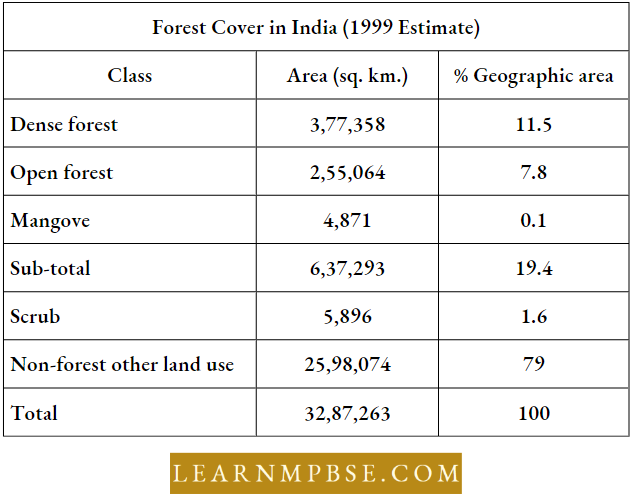
Differences Between Fresh Water Wetland And Marine Wetland. Freshwater wetlands including marshes, swamps and riverine are highly productive. Marine wetlands include highly productive estuaries and provide food and habitat to marine animals. Mangroves are the dominant plant species.
Differences Between Wetland And Grassland. Wetlands are low-lying areas usually covered by shallow water and have water-tolerant vegetation whereas grassland provides foliage and habitat to domestic animals and wildlife.
Differences Between Deforestation And Desertification. The cutting of forest is termed deforestation and conversion of grassland or forest into desert is desertification.
NEET Biology Biodiversity and Wildlife Conservation Ozone Layer
Ozone occurs in minute traces in the atmosphere. It has a peak concentration of around 25 km above the surface of the earth.
- At no level, the ozone’s concentration is more than a millionth of the main atmosphere.
- If the entire ozone content is compressed at normal pressure and temperature, it will constitute a layer of only 3 mm thick.
- Ozone has played a vital role in the evolution of life. Ozone plays a life-sustaining role by not allowing harmful radiation to reach the earth.
- 12 Mega diversity countries — India is one
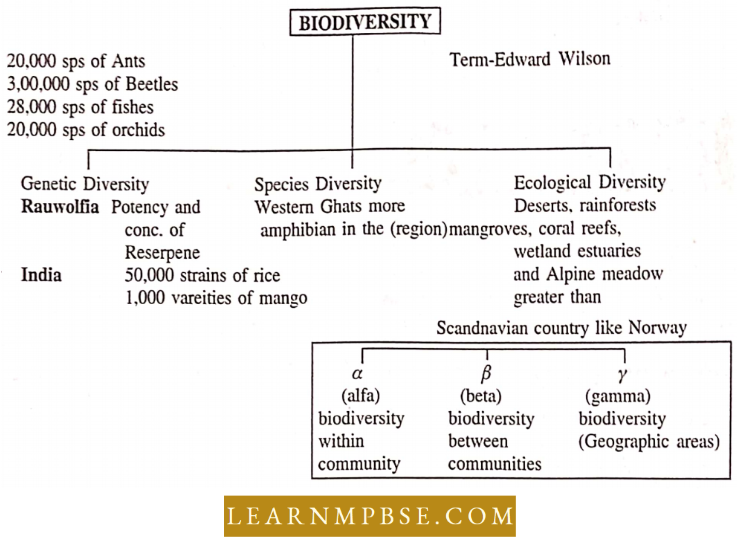
Patterns Of Biodiversity
- Latitudinal gradients.
- Species area – relationship.
Alexander Von Humboldt = log S = log C + Z log A
Importance Of Species Diversity To Ecosystem
- Stability
- Production
- Ecosystem Health
Loss Of Biodiversity
- Extinct
- Extinct in wild
- Critically endangered
- Vulnerable
- Low risk
- Data Deficient
- Not evaluated.
Causes Of Loss Of Biodiversity
- Habitat loss and fragmentation.
- Overexploitation.
- Alien species invasions.
- Co-extinctions
Conservation Of Biodiversity
- In-situ Conservation
- Hospoli
- Protected area,
- Sacred grooves
- Sacred forests.
- Gene banks and Seed banks
- Ex-Situ Conservation
- National Parks
- Sanctuaries
- Biosphere reserves
Biodiversity And Wildlife Conservation NEET Notes
Need For Conservation Of Biodiversity Species
- Narrow utilitarian
- Broadly utilitarian
- Ethical arguments
NEET Biology Biodiversity and Wildlife Conservation Questions From Competitive Examinations
Question 1. Number of Endangered Species of Angiosperms in India:
- 487
- 15, 000
- 5000
- 3000.
Answer: 4. 3000
Question 2. World Wildlife Fund was organised by UNESCO in:
- 1961
- 1983
- 1931
- 1915.
Answer: 1. 1961
Question 3. Todaba National Park is located in
- Mumbai
- Cochin
- Chennai
- Chandrapura
Answer: 4. Chandrapura
Question 4. The species of animal protected in Biligiri Rangaswamy National Park is:
- Panther
- Different species of birds
- Tiger
- Elephant.
Answer: 4. Elephant.
Question 5. The most threatening factor for the survival of plant biodiversity is:
- Destruction of natural habitat
- Biosphere reserve
- Vulnerable ecosystems like mangroves and wetlands
- Inaccesibility of habitat.
Answer: 1. Destruction of natural habitat
Question 6. In bioreserves is allowed.
- Restricted human population
- Private operations
- No human population
- Permanent human population.
Answer: 1. Restricted human population
Biodiversity And Wildlife Conservation NEET Notes
Question 7. Which endangered animal is the source of the world’s finest, lightest, warmest and most expensive wool-the shahtoosh?
- Chiru
- Nilgai
- Cheetal
- Kashmiri goat.
Answer: 1. Chiru
Question 8. According to Indian Forest policy what percentage of land area should be under forest cover?
- 13 per cent
- 23 per cent
- 33 per cent
- 43 per cent.
Answer: 3. 33 per cent
Question 9. Species listed in the “Red Data Book” are:
- Endangered
- Threatened
- Vulnerable
- All the above.
Answer: 4. All the above.
Question 10. Similipal is:
- Sanctuary
- National Park only
- Biosphere Reserve
- ZOO.
Answer: 3. Biosphere Reserve
Question 11. Which is the most effective way to conserve the plant diversity of an area?
- By creating biosphere reserve
- By creating botanical gardens
- By developing a seed bank
- By tissue culture method.
Answer: 1. By creating biosphere reserve
Question 12. Which one of the following is a pair of endangered species?
- Garden lizard and Maxican poppy
- Rhesus monkey and Sal tree
- Indian peacock and Carrot grass
- Hornbill and Indian Aconite.
Answer: 4. Hornbill and Indian Aconite.
Question 13. If the Bengal tiger becomes extinct:
- Hyaenas and Wolves will become scarce
- The wild areas will be safe for man and domestic animals
- Its gene pool will be lost forever
- The population of beautiful animals like deer will get stabilized.
Answer: 3. Its gene pool will be lost forever
Question 14. Which of the following animals is protected in Kaziranga Sanctuary of Assam?
- Indian bison
- Indian lion
- Indian rhinoceros
- Indian elephant.
Answer: 3. Indian rhinoceros
Biodiversity And Wildlife Conservation NEET Notes
Question 15. According to IUCN Red List, what is the status of Red Panda (Ailurus fulgens)?
- Vulnerable species
- Critically endangered species
- Extinct species
- Endangered species.
Answer: 4. Endangered species
Question 16. Biodiversity Act of India was passed by the Parliament in the year:
- 1996
- 1992
- 2002
- 2000.
Answer: 3. 2002
Question 17. One of the ex-situ conservation methods for endangered species is:
- Wildlife sanctuaries
- Biosphere reserves
- Cryopreservation
- National parks.
Answer: 3. Cryopreservation
Question 18. Genetic diversity in agricultural crops is threatened by:
- Introduction of high-yielding varieties
- Intensive use of fertilizers
- Extensive intercropping
- Intensive use of biopesticides.
Answer: 1. Introduction of high-yielding varieties
Question 19. Blackbuck (Autilope cervical) is an example of:
- Endangered species
- Extinct species
- Vulnerable species
- Conservation-dependent species.
Answer: 3. Vulnerable species
Question 20. Keystone species deserve protection because these
- Are capable of surviving in harsh environmental conditions
- Indicate the presence of certain minerals in the soil
- Have become rare due to overexploitation
- Play an important role in supporting other species.
Answer: 1. Are capable of surviving in harsh environmental conditions
Question 21. In India, we find mangoes with different flavours, colours, fibre content, sugar content and even shelf-life. The large variation is on account of:
- Species diversity
- Induced mutations
- Genetic diversity
- Hybridization.
Answer: 3. Genetic diversity
Question 22. Biosphere Reverses differ from national parks and wildlife sanctuaries because in the former:
- Human beings are not allowed to enter
- People are an integral part of the system
- Plants are paid greater attention than the animals
- Living organisms are brought from all over the world and preserved for posterity.
Answer: 2. People are an integral part of the system
Question 23. Which one of the following is the correctly matched pair of an endangered animal and a National Park?
- Great Indian Bustard — Keoladeo National Park,
- Wild ass — Dudhvva National Park
- Lion — Corbett National Park
- Rhinoceros — Kaziranga National Park.
Answer: 3. Lion — Corbett National Park
Question 24. Which of the following is considered a “hot spot” of biodiversity in India?
- Eastern Ghats
- Aravalli Hills
- Western Ghats
- Indo-Gangetic plain.
Answer: 3. Western Ghats
Question 25. Which one of the following is not included under in-situ conservation?
- Biosphere reserve
- National Park
- Sanctuary
- Botanical garden.
Answer: 4. Botanical garden
Types Of Biodiversity NEET Biology
Question 26. Which of the following parts of an animal and a plant represents endangered organisms in India?
- Cinchona and Leopard
- Banjan and Black buck
- Bentinckia nicobarica and Red Panda
- Tamarind and Rhesus monkey.
Answer: 3. Bentinckia nicobarica and Red Panda
Question 27. Which one is a critically endangered animal species?
- Antelope cervicapra
- Sus salvanius
- Ailttnts fulgens
- Caloles versicolor
- Hyla.
Answer: 2. Sus salvanius
Question 28. Which of the following regions of our country are known for their rich biodiversity?
- Western ghats and eastern Himalayas
- Western ghats and Deccan plateau
- Eastern Himalayas and gangetic plane
- Trans Himalayas and the Deccan peninsula.
Answer: 1. Western Ghats and the eastern Himalayas
Question 29. Pure clay is not suitable for plant growth because:
- It is chemically inert
- It is chemically active
- It forms a solid non-penetrable mass
- All of the above reasons.
Answer: 3. It forms a solid non-penetrable mass
Question 30. Humus is an example of:
- Soil structure
- Crystalloids
- Organic colloids
- None of them.
Answer: 3. Organic colloids
Question 31. Restoration of ecological equilibrium in mined areas can be achieved through:
- Prevention of grazing
- Prevention of soil erosion
- Revegetation of the mined habitats
- Conversion of mined habitats into agricultural ecosystems.
Answer: 3. Revegetation of the mined habitats
Question 32. In the Northern Indian plains, there is an increase in floods in recent times due to:
- Soil erosion in the plains
- Soil conservation on the hills
- Deforestation in the plains
- Deforestation in the catchment area.
Answer: 4. Deforestation in the catchment area.
Question 33. Laterization is a process that results in the:
- Degradation of soil
- Purification of water
- Formation of soil
- Sterilization of soil.
Answer: 3. Formation of soil
Question 34. Which of the following soils cracks and shrinks most as it dries:
- Porous soil
- Clay soil
- Loam soil
- Sandy soil.
Answer: 2. Clay soil
Question 35. What is the best pH of the soil for the cultivation of plants:
- 3.4 = 5.4
- 6.5 = 7.5
- 4.5 = 8.5
- 5.5 = 6.
Answer: 4. 5.5 = 6.
Types Of Biodiversity NEET Biology
Question 36. Deforestation causes:
- Soil erosion
- Soil pollution
- Water pollution
- Noise pollution.
Answer: 1. Soil erosion
Question 37. Which are the dense forests?
- Tropical evergreen forests
- Tropical deciduous forests
- Tropical Savannah
- Chaparral.
Answer: 1. Tropical evergreen forests
Question 38. Which of the following is the main reason for the extinction of animals?
- Predation
- Pollution
- Destruction of habitat
- Felling of trees.
Answer: 3. Destruction of habitat
Question 39. Rhizophora occurs in
- Mangrove
- Tropical rain forests
- Tropical deciduous forests
- Both (2) and (3)
Answer: 1. Mangrove
Question 40. The major fuel component of biogas is:
- CO
- CH4
- CH3
- CO2
Answer: 2. CH4
Question 41. Water infiltration will be slowest in:
- Black cotton soil
- Sandy soil
- Loam soil
- Red soil.
Answer: 1. Black cotton soil
Question 42. The amount of alcohol allowed to be mixed with petrol in India is:
- 10-15%
- 10%
- 5%
- 2.5%.
Answer: 3. 5%
Question 43. More than 70% of world’s freshwater is contained in:
- Antarctica
- Glaciers and Mountains
- Greenland
- Polar ice.
Answer: 4. Polar ice.
Question 44. Identify the odd combination of the habitat and the particular animal concerned:
- Sunderbans – Bengal Tiger
- Periyar – Elephant
- Rann on Kutch – Wild Ass
- Dachigam National Park – Snow Leopard
Answer: 2. Periyar – Elephant
Question 45. One of the endangered species of Indian medicinal plants is of:
- Ocimum
- Garlic
- Nepenthes
- Podophyllum
Answer: 4. Podophyllum
Question 46. In your opinion, which is the most effective way to conserve the plant diversity of an area?
- By developing a seed bank
- By tissue culture method
- By creating biosphere reserve
- By creating a botanical garden.
Answer: 3. By creating biosphere reserve
Question 47. Which of the following represents the maximum number of species among global biodiversity?
- Lichens
- Fungi
- Mosses and Fems
- Algae
Answer: 2. Fungi
Question 48. Manas Sanctuary is located at:
- Assam
- Bihar
- Gujarat
- Rajasthan.
Answer: 1. Assam
Question 49. Assertion (A): Tropical rainforests are disappearing fast in developing countries such as India.
Reason (R): No value is attached to these forests because they are poor in biodiversity.
- Both (A) and (R) are true and (R) is the correct explanation of the (A)
- Both (A) and (R) are true but the (R) is not the correct explanation of the (A)
- (A) is a true statement but (R) is false
- Both (A) and (R) are false.
Answer: 3. (A) is a true statement but (R) is false
Question 50. Habitat loss and fragmentation, over-exploitation, alien species invasion and co-extinction are causes of:
- Population explosion
- Migration
- Biodiversity loss
- Pollution
- Ecological succession.
Answer: 3. Biodiversity loss
Question 51. The venue and year of the Earth Summit on Conservation of Biodiversity was:
- South Africa, 2002
- Rio de Janeiro, 1992
- Johannesburg, 2004
- Stockholm, 1974
- Ramsar, 1974.
Answer: 2. Rio de Janeiro, 1992
Question 52. India became a party to the ‘Convention on Biological Diversity’ in the year.
- 1994
- 1993
- 1992
- 1983.
Answer: 1. 1994
Question 53. Which one of the following is not observed in biodiversity hotspots?
- Endemism
- Species richness
- Accelerated species loss
- Lesser inter-specific competition.
Answer: 4. Lesser inter-specific competition.
Threats To Biodiversity NEET Exam Preparation
Question 54. World Summit on Sustainable Development (2002) was held in:
- Brazil
- Sweden
- Argentina
- South Africa.
Answer: 4. South Africa.
Question 55. Which one of the following has the highest number of species in nature?
- Fungi
- Insects
- Birds
- Angiosperms.
Answer: 2. Insects
Question 56. Which one of the following shows the maximum genetic diversity in India?
- Groundnut
- Rice
- Maize
- Mango.
Answer: 2. Rice
Question 57. Which one of the following expanded forms of the following acronyms is correct?
- IPCC = International Panel for Climate Change
- UNEP = United Nations Environmental Policy
- EPA = Environmental Pollution Agency
- IUCN = International Union for Conservation of Nature and Natural Resources.
Answer: 4. IUCN = International Union for Conservation of Nature and Natural Resources.
Question 58. World Biodiversity Day is observed on:
- 3rd October
- 5th June
- 29th December
- 22th May.
Answer: 4. 22th May.
Question 59. The highest number of species in the world is represented by:
- Mosses
- Algae
- Lichens
- Fungi.
Answer: 4. Fungi.
Question 60. The relation between species richness and area is described on a logarithmic scale by the equation [where S = species richness, A = area, Z = slope of the line (regression coefficient), C = Y-intercept]
- log S = log C – Z log A
- log S = Z log A
- log S = log C + Z log A
- log S = log C
- log C = log S + Z log A.
Answer: 3. log S = log C
Question 61. Which one of the following is not used for ex situ plant conservation?
- Seed banks
- Shifting cultivation
- Botanical Gardens
- Field gene banks.
Answer: 2. Shifting cultivation

